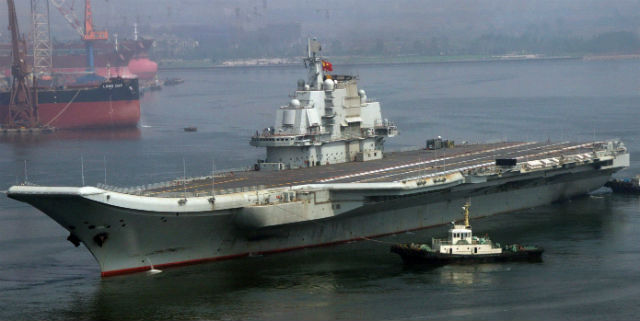Chinese naval aviation took an important step on 25 September, with the delivery of the first aircraft carrier to the People's Liberation Army Navy, although fixed-wing aircraft flight tests have yet to commence.
Formerly the Soviet carrier Varyag, the short take-off but arrested recovery (STOBAR) warship was officially named Liaoning, according to a story by Chinese state news agency Xinhua posted on the Chinese defence ministry website.
The delivery ceremony took place in the northern port of Dalian and was overseen by president Hu Jintao and premier Wen Jiabao. Prior to commencing sea trials in 2011, the ship spent six years in Dalian undergoing refurbishment by the China Shipbuilding Industry Corporation.
 |
|---|
| Rex Features |
The Xinhua story stated that the carrier will be used for training and "scientific research". This is consistent with experts' view on the ship's role, which has been the source of much speculation in recent years.
Though an impressive warship in its own right, the Liaoning suffers from several limitations. Her sister ship, the Russian flat-top Admiral Kuznetsov, is only capable of carrying approximately 40 fixed-wing aircraft and helicopters, while the US Navy's Nimitz-class carriers can carry up to 90 aircraft.
Moreover, STOBAR carriers are only capable of launching fighter aircraft owing to the power required for a ramp-assisted take-off. Though ramps are cheap and easy to maintain, the launching aircraft have to use a great deal of fuel, limiting their payload and range potential. Ramp launches also need significant deck space and only one aircraft can take off at a time.
The Liaoning will be capable of carrying integrated airborne early warning and control (AEW&C) system aircraft in the form of the Changhe Z-8AEW, a Chinese derivative of the Aerospatiale Super Frelon. AEW&C helicopters, however, are inferior to fixed-wing AEW&C aircraft such as the Northrop Grumman E-2 Hawkeye, which operates from the catapult assisted take-off barrier arrested recovery carriers operated by the US and French navies.
One industry expert refers to the Liaoning as a "self-licking ice cream cone", in which the carrier's air wing is only capable of protecting itself and the immediate area around the ship. Another says that aside from training pilots and sailors for yet-to-be-built Chinese carriers, the vessel would be useful for deploying an air cover umbrella several hundred miles from China's coastline, offering fighter protection for land-based maritime patrol and AEW&C aircraft.
The development status of China's first carrier-borne fighter, the Shenyang J-15 (a copy of the Sukhoi Su-33), is uncertain. Chinese media sources failed to indicate when flight tests will commence aboard the Liaoning.
Source: Flight International























